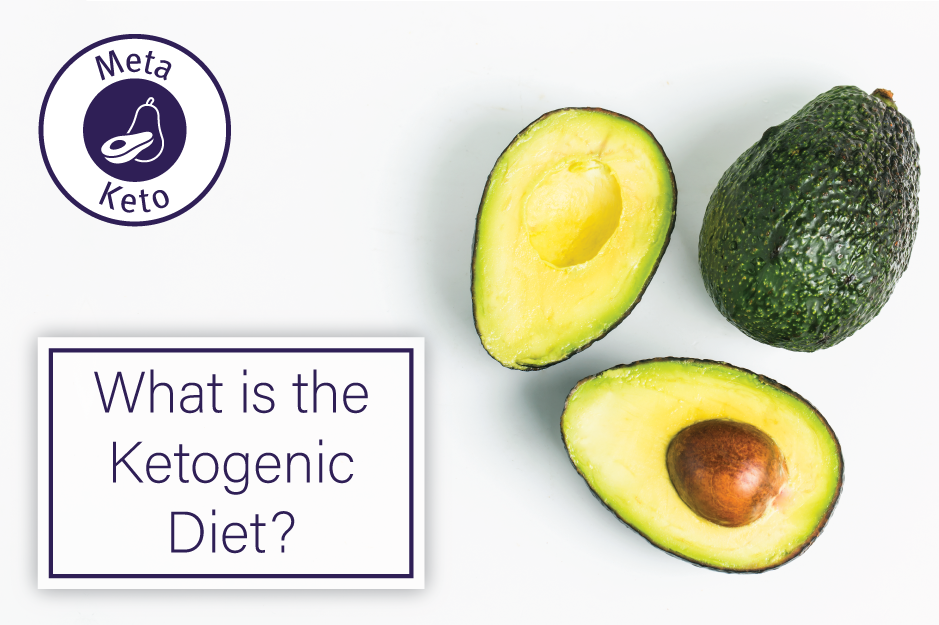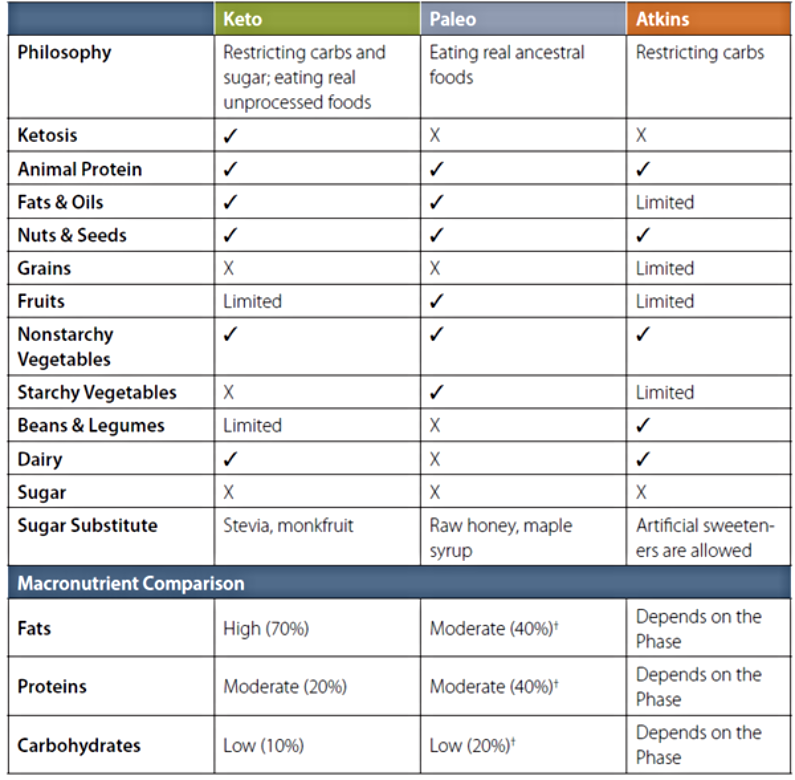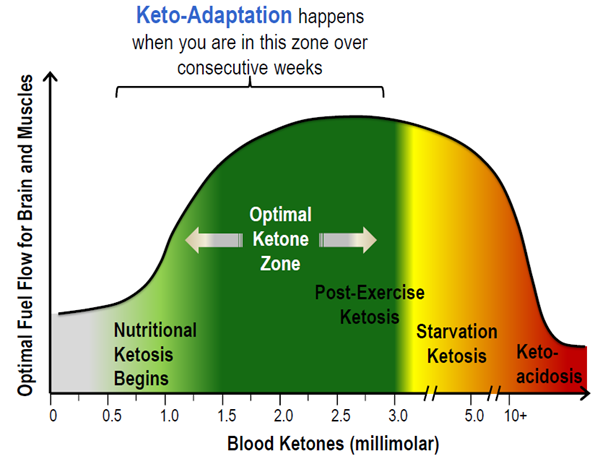|
1. What is the ketogenic diet?
Low in carbohydrates with moderate protein and high in fat, a ketogenic diet prompts the body to burn fat for energy rather than glucose, which leads to the production of ketone bodies—molecules that can be used as a source of fuel. A typical ketogenic diet consists of ~70% fat, 20% protein, and 10% carbohydrates. Though this can vary slightly depending on the individual, this diet is specifically designed to induce nutritional ketosis. 2. What is ketosis? When ketone bodies accumulate in the bloodstream (>0.5 mmol/L) due to low glucose availability, they cause a metabolic state called ketosis. The most efficient approach to induce nutritional ketosis is to lower dietary carbohydrate intake while increasing fat intake. This reduction in carbohydrate intake helps the body shift toward a state that promotes the breakdown of fats (from the diet and your body) to produce ketone bodies and enter ketosis. 3. How does the ketogenic diet differ from a paleo diet, Mediterranean, Atkins? One diet does not fit all—the best diet is the one that you can stick with for long-term. As a lifestyle modification, it should be closely monitored and modified as needed.
4. What is intermittent fasting? How is this beneficial for someone on ketogenic diet?
Intermittent fasting (IF) limits the eating window to just a few hours a day. However, during this window, one simply eats to feel full. This practice allows the body to increase the amount of food intake at one time, and induce adaptive metabolic changes. There are many different variations of intermittent fasting,and many different reasons for doing so. Some people may experience mental clarity and focus as well as using intermittent fasting to get over a plateau. 5. What are ketones? How are they produced? Ketone bodies production in the liver is a natural process when the body increases the use of fat as the main source of fuel. This occurs during a fasting state and/or prolonged exercise, or when dietary carbohydrates are very low. There are three endogenous ketone bodies. These are acetone, acetoacetate and beta-hydroxybutyrate (βHB). When following a ketogenic diet, your brain, as well as other organs and tissues, depend on ketones as an energy source. Ketones can be measured in the blood, breath and urine, and measuring can be helpful when following a ketogenic diet or program to ensure that the desired level of ketosis is reached and maintained. 6. What is keto-adaptation? How long does it take to adapt? Keto-adaptation is the process the body goes through during the ketogenic diet as it switches to using fat as an energy source rather than glucose. The length of time varies for individuals, but typically starts a few days after being on a ketogenic diet. Within a week to two weeks, many people report positive effects of keto-adaptation, and studies have shown that signs of keto-adaptation (such as increase in fat oxidation) occur within this time-frame. 7. What are exogenous ketones vs. endogenous ketones? Are there benefits to taking exogenous ketones? Exogenous ketones are ketone bodies in either mineral or ester forms that can be ingested as a nutritional supplement, producing acute elevations in circulating ketone levels. Nutritional ketosis resulting from adherence to a ketogenic diet is often referred to as endogenous ketosis in contrast to peripheral ketosis induced by supplementation, referred to as exogenous ketosis. 8. Which patients or individuals would be excluded or not advised to follow a ketogenic diet? While the ketogenic program can benefit a wide array of patients, it may not be suitable for patients with possible inborn metabolic disorders (CPTI or II deficiency; β-oxidation defects [LCAD, MCAD, SCAD]; and pyruvate carboxylase deficiency). Caution should also be used in patients with the following conditions:
Depending on the health goals, the practitioner may recommend a specific time period for the patient to be on the ketogenic diet. There are many people and cultures that go into ketosis and stay there for a long period of time without any negative effects. 10. Can someone just dabble in keto for a few days/weeks? Can they still get benefits? While there is evidence to support the long-term use of ketogenic diets without serious side effects, there are also benefits to just doing a cyclical ketogenic diet. We encourage patients to stay on the ketogenic program for a period of 6-12 weeks as it takes some time for the body to be “keto-adapted” and for them to start seeing results. 11. During the keto-adaptation process, which noticeable changes are expected and what is the “keto flu”? During the keto-adaptation process, many people may experience symptoms of the “keto flu”. These symptoms occur because the body, being used to utilizing carbohydrates as main source of energy, is going through a metabolic shift to burn fat instead. Some people describe this as a feeling of withdrawal. Symptoms one may experience include feeling drowsy, achy, nauseous, dizzy, and irritable. Some may even experience cramping, stomach pains, and muscle soreness. 12. How long do these symptoms last? It varies for the individual, but the keto flu lasts typically a week or less for the average person and not everyone experiences the keto flu. However, below are some anecdotal ways to mitigate symptoms of the keto flu. Increase electrolyte intake, but avoid those electrolyte sports drinks with high sugar.
Ketones can be measured in a variety of ways via a breath meter, urine strips, or a blood meter. The blood meter is the most accurate way to measure the levels of ketones (primarily βHB) in the body. However, this method is more invasive than others, and can also be significantly more expensive. Your healthcare practitioner can advise you on commercially available blood meters to test ketone levels by looking at circulating levels of βHB measured in millimolar (mmol/L) units. 14. What levels should be achieved (millimolars)? While variable among individuals, βHB ranges >0.5mmol are considered the beginning of the range of nutritional ketosis and a range at which clinical benefits (for example to body weight management) have been described. Work is ongoing to understand the optimal range of circulating ketones for different outcomes.
15. Why is it important to incorporate as we age?
The healthy young brain relies solely on glucose to obtain energy for its functional and structural needs. During healthy aging, brain glucose uptake is 10-15% lower and can be up to 35% lower in certain brain areas in neurological disorders such as Alzheimer’s Disease. In contrast, brain uptake of ketones appears to still be normal in the brains of Alzheimer’s disease patients. A common misconception is that the brain can only use glucose. Ketone bodies are the only alternative source of energy for the brain as it cannot utilize free fatty acids (FFAs). Both rodent and human studies have shown increase uptake of ketone bodies by the brain following peripheral infusion of ketones, prolonged fasting, or a ketogenic diet. They observed that up to 70% of brain’s energy demands were provided by ketone bodies available in circulation (blood) and taken up by the brain. 16. Why is it used for weight loss? Ketogenic diets that are rich in fat and low in carbohydrate induce a decrease in blood sugar and insulin levels. A reduction of circulating insulin levels causes an increase in the metabolism of fatty acids (increased lipolysis-the breakdown of lipids) from adipose tissues for utilization as energy. The liver uses FFA derived from dietary source and release from adipose tissue to oxidize and generate ketone bodies in order to meet the energy demand. Ketone bodies in circulation provide a stable source of fuel for the body and the brain, thereby sparing the need to break down muscle protein into glucose as energy supplies. A ketogenic diet encourages the burning of body fat as fuel, as well as inducing satiety between meals. Additionally, a ketogenic diet may help suppress appetite and reduce cravings. 17. Why is it used to prevent cognitive decline? With a ketogenic diet, the brain utilizes ketone bodies instead of glucose as its primary fuel source. This switch can help encourage more nerve growth factors and synaptic connections between brain cells, and result in increased mental alertness, sharper focus, and improved cognitive capabilities. 18. Why is it used for diabetes? Studies have shown that low-carbohydrate diets help support insulin metabolism in the body. This is because the absence of carbohydrates in the diet can reduce circulating insulin concentrations and contribute to glucose control. 19. Will this affect cholesterol? Isn’t this diet is too high in fat for weight loss or CVD patients? The ketogenic diet, as many diets, can positively influence body weight and cardiometabolic health and potentially improve dyslipidemia. Ketogenic diets are by design high in fat, and the type of fat is an important consideration as is the overall quality of the foods eaten within the diet. In terms of cholesterol levels, although there are studies to show that total cholesterol and total LDL cholesterol may increase on a ketogenic diets, more detailed analysis of cholesterol profile has shown the following:
20. Why do athletes use it? Low-carbohydrate, high-fat and ketogenic diets are increasingly adopted by athletes for body composition and sports performance enhancements. There is not one diet that fits all or perhaps most. The literature on ketogenic diets in athletes is limited but variable with some studies showing no negative impact and others suggesting that a ketogenic approach may not be ideal. As the science evolves in this area, current thinking is that the health status of the individual athlete and type of exercise (endurance vs high intensity) they are performing is important. For example, a ketogenic approach has been discussed as being beneficial for those participating in endurance activities, or for those who need to increase power-to-weight ratio, however specific studies in these areas are currently lacking. 21. Isn’t glucose needed for energy for workouts? Carbohydrates only go so far to sustain energy throughout the day, and especially during a workout. In ketosis, your body uses fat as fuel instead of glucose, to provide the brain with a consistent supply of the ketone bodies necessary to sustain physical performance. 22. Isn’t this diet too low in protein for my patients with sarcopenia or who are athletic? Studies show that low carbohydrate ketogenic diet is effective in body weight reduction without inducing lean body mass loss, preventing the risk of sarcopenia. Consumption of approximately 25–30 grams of high-quality protein per meal maximally is recommended to stimulate muscle protein synthesis and slow sarcopenic muscle loss. 23. Doesn’t the brain need glucose to function? A common misconception is that the brain can only use glucose. Ketone bodies are the only alternative source of energy for the brain as it cannot utilize FFAs. Both rodent and human studies have shown increase uptake of ketone bodies by the brain following peripheral infusion of ketones, prolonged fasting, or a ketogenic diet. They observed that up to 70% of the brain’s energy demands can be provided by ketone bodies available in circulation (blood) and taken up by the brain. 24. Will insulin resistant patients need to be on this diet the rest of their lives? Modifying lifestyle behaviour including weight-loss and exercise are considered to be methods in restoring the ability of tissues to properly respond to insulin. Although a ketogenic diet with low carbohydrate intake can effectively improve insulin sensitivity, the duration of diet for which these patients should be on is of healthcare practitioner’s decision. As the patient makes other important diet and lifestyle changes and maintains these healthy behaviours, it may be possible to re-introduce dietary carbohydrates (with a focus on lower glycemic index/load sources) which may be tolerated with improved insulin sensitivity. 25. Isn’t this diet too acidic? Diabetic ketoacidosis happens when extremely high levels of ketone bodies are presented in the blood (normally > 5 mM). Therefore, the blood can turn more acidic. However, during nutritional ketosis you might experience a small, transient decrease in serum bicarbonate in conjunction with mild ketosis which can be minimized by increasing electrolyte intake. Hence the need for following this dietary approach under the supervision of a healthcare practitioner and for periodic monitoring of biological parameters is recommended. 26. Do I have to restrict calories on the ketogenic diet in order to lose weight or just follow the macronutrient plan? What about if I am not trying to lose weight but just want to follow the keto diet? A caloric deficit will allow your body to mobilize stored fat deposits for energy utilization. If weight loss is not a goal, there is no need for caloric deficit and you can still get the benefits associated with the keto-adapted state of nutritional ketosis. 27. I can’t recommend this diet because less than 25g of CHO’s would be impossible for my patients to adhere to. The exact amount of carbohydrate intake to reach nutritional ketosis requires an individual assessment as several parameters need to be taken into account (gender, age, physical activity, insulin sensitivity, among others). Hence, the need for following this dietary approach under the supervision of a healthcare practitioner and for periodic monitoring of biological parameters (see question 19) is recommended. A carbohydrate intake of less than but close to 50 grams per day is acceptable for some individuals to reach a state of nutritional ketosis. 28. How do I count the carbs allowed per day? Are fibre included – do these count towards the total carbs allowed per day? When following a ketogenic diet, it is important to consider the individual when determining the total amount of carbohydrates per day. Several factors will influence the ‘carb tolerance’ of an individual, such as gender, age, physical activity and insulin sensitivity among others. As a general recommendation, you will want to start with total carbohydrates intake below 50 grams per day. This number can be reassessed after the first two weeks to optimize your individual threshold for carbohydrate intake and maximize the benefits from reaching a state of keto-adaptation. Please let us know if we can provide any further information *References available Kind regards The Amipro | Metagenics Team
Click to set custom HTML
3 Comments
17/8/2023 04:16:02 am
This is nice content from you. I really appreciate for that. Thank you so much for that.
Reply
Tom
3/10/2023 10:40:43 am
I was skeptical, but this weight loss product proved me wrong. From 95kg to a fit and fabulous 65kg, it delivered beyond my expectations. Say goodbye to excess weight and hello to a healthier you - <a href="https://298d9dw5os10btbhn4wbr02tfx.hop.clickbank.net" target="_blank">click here</a> to begin your transformation!
Reply
John Doe
29/1/2024 03:38:10 am
Tired of battling stubborn fat? This weight loss product is the answer! From 85kg to a lean 55kg, I'm now living my best life. <a href="https://831e9dw86ucxdr2m1mxjw4x61g.hop.clickbank.net" target="_blank">click here</a> to take control of your weight and health!
Reply
Leave a Reply. |
Categories
All
Archives
April 2024
|
|
Join Our Community
|
|
Amipro Disclaimer:
Certain persons, considered experts, may disagree with one or more of the foregoing statements, but the same are deemed, nevertheless, to be based on sound and reliable authority. No such statements shall be construed as a claim or representation as to Metagenics products, that they are offered for the diagnosis, cure, mitigation, treatment or prevention of any disease. |





 RSS Feed
RSS Feed